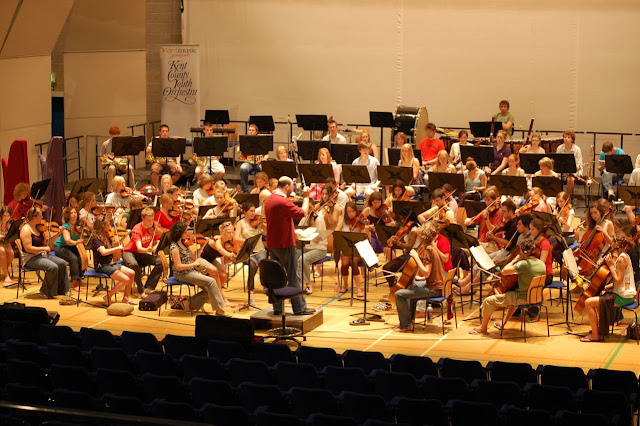The Sibelius symphonies are full of difficulties for the conductor, instrumentalists and even the audience. Though the whole of his Fifth Symphony is shorter than the Finale of Mahler 2, it’s just as difficult a work to put together, and in some ways more so. For the conductor in particular, I think the Sibeliuses are, on balance, harder to conduct successfully than the Mahler, Brahms, Bruckner or Shostakovich symphonies.
The first half-movement of the symphony (from the beginning to the ¾ section) shares with works like Brahms 3 the difficulty of fitting a great deal of activity, much of it syncopated or full of hemiolas, within a slow basic pulse. It requires a lot of confidence and inner rhythm from the conductor, but at the end of the day, it only works if the players are all subdividing in the same way. With an inexperienced orchestra, things quickly start to swim when players misunderstand what their colleagues are doing, or don’t maintain their subdivisions in long notes. As we started rehearsing in earnest on Tuesday, I began with a simple exercise- having all the winds (the opening of the symphony is only horns, woodwinds and timpani for the first few minutes) gently tongue each triplet 8th note they play. Twice through in this manner, and things began to feel quite secure and confident. In my experience, subdivision fixes almost everything.
I’ve actually come to look at the entire first movement of the symphony (through the end of the ¾ section) as something quite like a double theme and variation form. The A theme is based on the rising fourth melody in the horns and the bucolic melody in thirds in the winds which follows. The B theme is more abstract- a short chromatic theme in first heard in the winds the bar before A, music of high rhythmic density in the strings, and a long, angular and anguished melody that is actually a variation itself of the opening horn theme. Put very simply, the A theme is always quite hopeful, the B theme troubled and threatening. In each variation, the B theme is developed further and further, with the string writing becoming ever-more intense and bizarre.
Most challenging for the orchestra is what I call the 2nd variation (beginning at letter J), where the solo bassoon plays a long extrapolation of the chromatic theme over a ferociously dissonant and relentlessly abstract string accompaniment in 9tuplets (really problematic from K on). I’ve seen many a performance crash and burn here, because it’s very difficult to keep everyone steady in such a slow pulse, and if things start to swim, there are no harmonic arrivals to cling too for a long time.
Fortunately, the music is constructed more simply than it sounds- the first violins and cellos function as a team as do the 2nds and violas. In the first part of the section (from the fourth bar of J), both teams are playing sequences using the siciliana rhythm, but set off from each other by a triplet eighth note. Also, the 1sts and cellos move chromatically in octaves, while the 2nds and violas move diatonically (at least semi-diatonically) in parallel thirds. Later, when everyone moves to 9tuplets, the 2nds and violas play in unison, but remain a pair, as do the cellos and firsts. So, if one rehearses the entire passage 3 times very slowly (beating quite leisurely in 12), once with the cellos and firsts, once with the 2nds and violas and once with all the strings together (non vibrato sempre!), the players can hear the patters, listen to how the two parts interact and begin to get this very chromatic music in their ears.
I’ve always rehearsed this passage this way, and so far, it’s always gone well in concerts. I know many conductors who are afraid to do slow work for fear of appearing pedagogical or boring the players, but a passage this dissonance and abstract, I think the musicians of any orchestra appreciate it, and the entire exercise takes only 4 or 5 minutes. Something that feels like chaos at first, starts to feel musically coherent, if somehow still spiritually unknowable.

Recent Comments